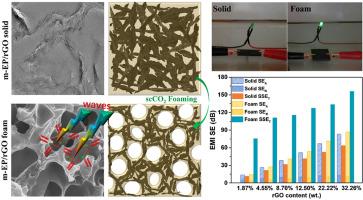Composites Science and Technology ( IF 8.3 ) Pub Date : 2021-08-18 , DOI: 10.1016/j.compscitech.2021.109000 Xun Fan 1 , Qiang Gao 1 , Yusong Gao 2 , Geyang Zhang 2 , Fei Huang 3 , Ronglin Xiao 3 , Wei Liu 1 , Fengchao Wang 2 , Jianbin Qin 1 , Emiliano Bilotti 2, 4 , Han Zhang 2, 4 , Xuetao Shi 1 , Guangcheng Zhang 1

|
With the rapid evolvement of wireless communication technologies, the ever increasing needs to prevent electromagnetic waves (EMWs) pollution have urged the development of lightweight materials with excellent electromagnetic interference (EMI) shielding property. However, achieving desired EMI shielding performance often requires high loadings of conductive nanofillers, like graphene, which poses challenges to control the nanoparticle dispersion and the mechanical performance of the nanocomposite. Herein, we demonstrate a method to fabricate highly-loaded (>30 wt%) graphene in microcellular epoxy nanocomposites, successfully overcoming the long-lasting dichotomy in the field of nanocomposites of high filler loading and dispersion. By utilizing supercritical CO2 foaming method, modified thermosetting epoxy-based nanocomposite was foamed with multiple interfaces and tunable microcellular cells. In addition, a rearrangement of nanofillers during foaming process is favorable for more intense conductive network, leading to enhanced EMWs attenuation by repeated reflections and absorptions. An optimal combination of electrical conductivity (314 S m−1), EMI shielding effectiveness (86.6 dB and 156.3 dB/(g/cm3)), compressive strength (27.4 MPa) and density (0.55 g cm−3) has been achieved for foamed nanocomposite with 32.26 wt % graphene content. This versatile method opens up an easy route to fabricate lightweight structural foams with high nanofiller contents, which could be used in many applications such as electronics, robotics, and aircrafts.
中文翻译:

通过克服纳米填料负载/分散二分法,具有出色电磁干扰屏蔽和机械性能的微孔环氧树脂/石墨烯纳米复合材料
随着无线通信技术的快速发展,对防止电磁波(EMW)污染的需求不断增加,促使开发具有优异电磁干扰(EMI)屏蔽性能的轻质材料。然而,实现所需的 EMI 屏蔽性能通常需要高负载的导电纳米填料,如石墨烯,这对控制纳米颗粒分散和纳米复合材料的机械性能提出了挑战。在此,我们展示了一种在微孔环氧树脂纳米复合材料中制造高负载(> 30 wt%)石墨烯的方法,成功克服了高填料负载和分散的纳米复合材料领域的长期二分法。通过利用超临界 CO 2发泡方法,改性热固性环氧基纳米复合材料发泡,具有多个界面和可调微孔细胞。此外,发泡过程中纳米填料的重排有利于形成更强烈的导电网络,通过重复反射和吸收导致增强的 EMW 衰减。电导率 (314 S m -1 )、EMI 屏蔽效率 (86.6 dB 和 156.3 dB/(g/cm 3 ))、抗压强度 (27.4 MPa) 和密度 (0.55 g cm -3 ) 的最佳组合) 已经实现了具有 32.26 wt% 石墨烯含量的泡沫纳米复合材料。这种通用方法为制造具有高纳米填料含量的轻质结构泡沫开辟了一条简单的途径,可用于许多应用,如电子、机器人和飞机。











































 京公网安备 11010802027423号
京公网安备 11010802027423号